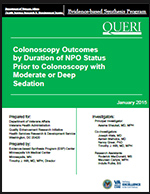
Principal Investigator:
Aasma Shaukat, MD, MPH
Co-Investigators:
Joseph Wels, MD;
Ashish Malhotra, MD;
Nancy Greer, PhD;
Timothy J. Wilt, MD, MPH
Download PDF: Complete Report, Executive Summary, Report, Appendices
Fourteen million colonoscopies are performed annually in the United States for screening, diagnosis, surveillance, and treatment of numerous colonic conditions. Colonoscopies require bowel preparation for cleansing to sufficiently visualize the colon lining, identify and treat suspected lesions, and maximize quality and safety. To optimize colon lining visualization, patients are advised to divide the bowel preparation regimen over two sessions (known as "splitdose preparation"): 1) the evening prior to the colonoscopy (PM dose) and 2) the morning of the colonoscopy (AM dose), the latter taken ideally within 2-6 hours of the planned procedure. In addition, some level of sedation (typically moderate or deep) is used in almost all colonoscopies to facilitate patient comfort and procedure quality.
There is significant variation among anesthesia providers as to the acceptable timing of NPO ("nothing by mouth"), including how many hours prior to the planned procedure the last bowel preparation dose can be taken, in order to minimize anesthesia risk (primarily pulmonary aspiration requiring hospitalization). Practice guidelines from the American Society of Anesthesiologists suggest a minimum fasting period of 2 hours for clear liquids and 6 hours for a light meal (ie, toast and clear liquids). The guideline authors note that published clinical evidence is insufficient to clearly define a relationship between NPO status and risk of emesis/reflux or aspiration.
There is a need to balance optimal colonic preparation, patient convenience, and scheduling efficiency (typically a shorter NPO window status) with anesthesia safety concerns for an elective procedure (typically a longer NPO status). In addition, performing procedures with moderate or deep sedation requires development of and adherence to local and/or national policy measures that cross multiple procedures and physician specialties. These policies include recommendations regarding NPO status.
The purpose of this report was to review the evidence on the relationship between timing of NPO and 1) the incidence of aspiration and other anesthesia-related harms during elective colonoscopy and 2) colonoscopy rescheduling. We also reviewed the evidence on the benefits and harms of variable timing of NPO status on colonoscopy outcomes including colonoscopy quality measures, resource use, and patient satisfaction. The review may be used to guide policy within the VA. We addressed the following key questions:
Key Question 1: Does the incidence of aspiration and other anesthesia-related harms for colonoscopy vary by NPO status or bowel prep timing (eg, > 6 hours, 2-6 hours, < 4 hours, and < 2 hours)? Does the incidence of anesthesia-related harms by NPO status vary by: a) patient characteristics (age, race, sex, obesity, comorbidities) or b) sedation (moderate, deep)?
Key Question 2: What is the effect of variable timing of bowel prep and NPO status on the quality of the bowel preparation, diagnostic yield, and colonoscopy procedural quality indicators (eg, completion rates, adenoma detection rate, total procedure time, cecal intubation time and withdrawal time)?
Key Question 3: What is the effect of NPO status prior to colonoscopy on resource use (eg, costs, unused procedure slots, delays in rescheduling, delays in diagnosis, increased volume of procedures, scheduler and nursing time associated with cancelled or delayed procedures)?
Key Question 3: What is the effect of bowel preparation and NPO status prior to colonoscopy on patient adherence to bowel preparation, colonoscopy, and/or rescheduled colonoscopy, and satisfaction with bowel preparation and/or colonoscopy?)?
Colonoscopy Outcomes by Duration of NPO Status (Management eBrief)
Shaukat A, Malhotra A, Greer N, MacDonald R, Wels J, Wilt TJ. Systematic review: outcomes by duration of NPO status prior to colonoscopy. Gastroenterology Research and Practice. 2017. Article ID 3914942. doi: 10.115/2017/3914942.
ESP Report: Colonoscopy Outcomes by Duration of NPO Status Prior to Colonoscopy with Moderate or Deep Sedatione (Cyberseminar)